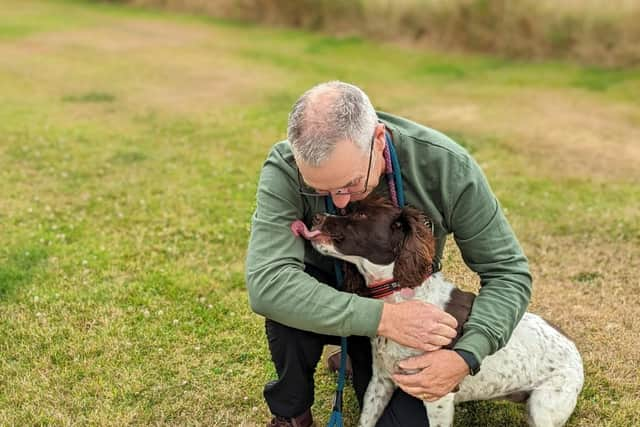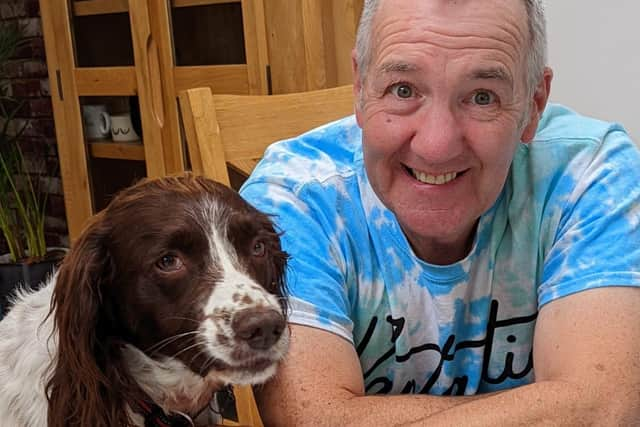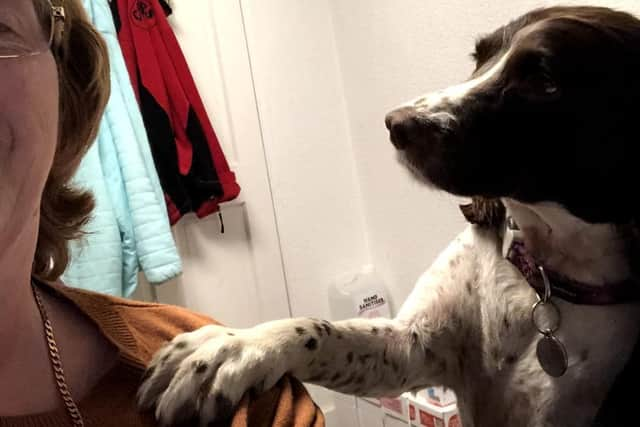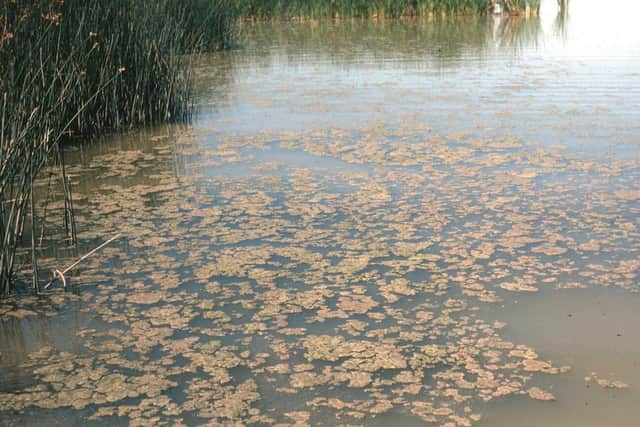Owner of Chorley taxi company forced to put beloved family pet down from suspected poisoning after a walk
and live on Freeview channel 276
Philip Cooper, 59, from Euxton, who owns family-run Cooper's Taxis in Chorley, says he took his nine-year-old springer spaniel Poppy for a walk in Astley Park and two days later she was dead from suspected blue-green algae poisoning.
Taking Poppy and her sister Maisie - a 21-month-old springer spaniel for a stroll last Sunday afternoon where he believes the poisoning took place, he said: "I went to the park with the dogs around midday and walked through the wooded section to the end where it opens up to a grass expanse.
"We sat for half an hour and then went towards the carpark.
Advertisement
Hide AdAdvertisement
Hide Ad

"The dogs went everywhere together - the little one followed the older one apart from one time when Poppy disappeared for around five minutes.
"I started getting anxious and then she just turned up.
"Whenever she disappears she always goes into water so we think it was something in the lake that poisoned her.
"I got them both home and showered and dried and they both seemed fine for the rest of the night."


What happened to Poppy after her walk?
Between 4am-5am the next morning Philip says Poppy asked to be let outside for the toilet and then came back in. A few hours later she wanted to go out again.
Advertisement
Hide AdAdvertisement
Hide AdNoticing something was wrong at this point Philip said: "I observed her stance outside and it wasn't as normal. She had thrown up sick yellow bile and diarrhoea.
"We waited an hour and had our breakfast and she had diarrhoea again and vomited which looked muddy.


"We took the dogs to work at around 11am and could see Poppy starting to struggle so we took her to the vets.
"She pooed on the floor and this time it was pure blood.
"Initial treatment was for sickness and diarrhoea which is not uncommon for dogs to suffer simple stomach upsets so she was given an anti-sickness and pain relief injection and prescribed some antibiotics."
Advertisement
Hide AdAdvertisement
Hide AdAs the day progressed however, Poppy started to rapidly deteriorate and she was taken to the vets once again around 5pm where they realised they were dealing with a much more serious illness than they had originally thought.


The family left her with the vets and received a progress call at 11am telling them to expect the worst.
A shocked Philip added: "We were told she would not make it through the night and expected to get another call. This never happened so we fell asleep.
"The following morning we received a call at 9am to say she was still with us and that they were doing tests which could indicate certain parasites.
Advertisement
Hide AdAdvertisement
Hide Ad"We went back to the vets around 9.15am and stayed with Poppy until about 1pm. She was out of it on medications but she knew we were there with her."
Results of a mobile X-ray team who were doing scans to check for a cancerous tumour or canine parvovirus were both ruled out.


Philip said: "They think Poppy's death was caused by green and blue algae, but this cannot be absolutely confirmed.
"We were told that her intestinal damage was so bad that she had no chance of recovery.
Advertisement
Hide AdAdvertisement
Hide Ad"We put her to sleep at around 4pm on Tuesday and gave the okay for her to be cremated.
"As soon as she passed away more blood shot out of her nose and rectum and a black greasy substance came out of her mouth."
Describing his family member, Philip said she had certain intuition built in.
"She could sense stress and would jump up and place her paw on my wife Lynne to tell her to stop working.
Advertisement
Hide AdAdvertisement
Hide Ad"She might have been getting on but she was very fit, strong and powerful with no health issues and was the perfect weight."
Kind hearted Philip sent the vet who looked after Poppy flowers.
"We have been using Hillcrest Vets for 30 years now and they have been very good.
"The vet surgeon called Elizabeth who oversaw Poppy's condition was very caring and compassionate."
Advertisement
Hide AdAdvertisement
Hide AdIssuing a warning to other dog walkers, he added: "As beautiful as nature looks it can be very deadly.
"Blue and green algae is everywhere. We have learned that it is most potent during warm weather.
"There is never a sign that warns of algae and there needs to be.
"My dog was fine Sunday, but by Tuesday she was dead."
Veterinarian Elizabeth Joseph, 51, who has worked at Hillcrest Animal Hospital in Chorley for four years, said that although there is no diagnostic test for blue-green algae, it was highly likely that it was the cause of Poppy’s death.
Advertisement
Hide AdAdvertisement
Hide AdShe said: “Although we cannot say for concrete certainty, Poppy swam in the water so it is highly likely it was blue-green algae as most of the symptoms were there.
"We are awaiting blood test results which can take up to five days.”
What did the council say?
Councillor Adrian Lowe, Executive Member for Customer, Streetscene and Environment at Chorley Council said: “We haven’t received any reports of blue-green algae in Astley Park woods and our Rangers have been out and inspected the area and found no evidence of blue-green algae.
"We appreciate that this is a concern for dog owners and will continue to monitor the area.”
Advertisement
Hide AdAdvertisement
Hide AdWhat is blue-green algae and what does it look like?
Blue-green algae is a term used to describe a group of bacteria, called cyanobacteria.
They are not actually algae, but the organisms got this name because they often give the appearance of algae when they clump together in bodies of water.
When the algae blooms, it can give look like a blue-green scum has appeared on the surface of the water. It sometimes looks a bit like pea soup.
Blooms of the organisms often build up around the edges of ponds and lakes, which may look like foam.
Advertisement
Hide AdAdvertisement
Hide AdWhy is it harmful to dogs?
Blooms of blue-green algae can produce harmful toxins which stop a dog’s liver from functioning properly. However, not all types of blue-green algae are dangerous.
Sadly, exposure to toxic blue-green algae is often fatal, and can also cause long term health problems in dogs that survive after drinking or swimming in algae-contaminated water. Some types of blue-green algae can kill a dog just 15 minutes to an hour after drinking contaminated water.
Dogs who have been swimming in water can get the algae caught in their fur, and can ingest it while cleaning themselves later on.
What are the symptoms of blue-green algae poisoning?
If your dog shows any of the following signs after drinking from, or swimming or paddling in water, contact your vet immediately and tell them you are concerned about blue-green algae:
Vomiting/being sick
Diarrhoea
Seizures/fitting
Weakness/collapse/unconsciousness
Disorientation/confusion
Drooling
Breathing difficulties
Advertisement
Hide AdAdvertisement
Hide AdThere is no antidote for the toxins produced by the bacteria, but if caught early enough, your vet will likely try to make your dog sick and attempt to flush the toxins from the body before they take hold.
If you have concerns contact your vet immediately.
Comment Guidelines
National World encourages reader discussion on our stories. User feedback, insights and back-and-forth exchanges add a rich layer of context to reporting. Please review our Community Guidelines before commenting.
